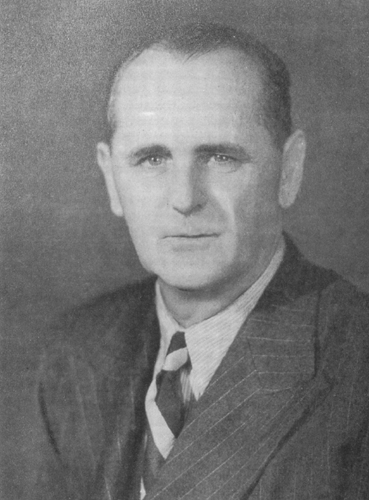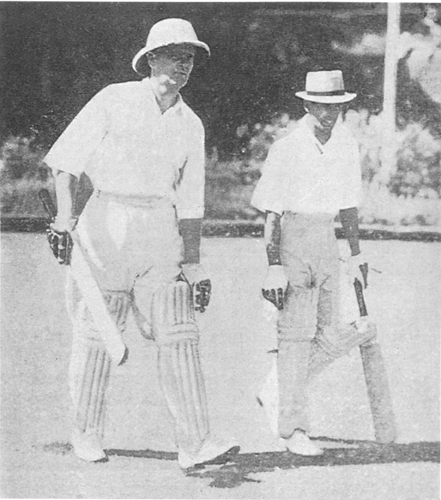
Conrad Powell Johnstone.
|
No history of Madras or Tamil Nadu cricket can be complete without an account of the exploits of Conrad Powell Johnstone CBE (August 19, 1895-June 23, 1974). Johnstone led the Madras Cricket Club in local cricket, Europeans in the Presidency Match, and Madras in the Ranji Trophy in its infancy. He was also President of the Madras Cricket Club in 1947.
Johnstone was born in Sydenham, London, and grew up in England, playing representative cricket for Rugby School, Cambridge University and Kent. (In the intervening years, he served in the Army during the Great War and suffered two bullet wounds, one of them a narrow miss that almost took his life.) He joined Cambridge in 1918 with his military gratuity, became a law graduate and earned university Blues for both cricket and golf. With 78 runs, he topscored in the 1919 university match against Oxford and captained the Cambridge golf team that defeated Oxford in 1920. He played for Kent in 1919, when it finished runner-up in the county championship.
A major contribution by Johnstone to Indian sport was spotting and nurturing talent, often by way of jobs in Burmah Shell, the firm he came out to work for. Johnstone paved the way for many a young sportsman to pursue his sport with the livelihood security that a steady job provided, pioneering this uniquely Madras institution of sports promotion through employment. His most famous recruit into Burmah Shell was the double international M.J. Gopalan whose hockey and cricket commanded a huge fan following.
Johnstone was himself an excellent all-round cricketer, the first left hand batsman of the province to capture the imagination of its cricketing public. In 1926, he played for the first time in the Presidency Match – the annual contest between the Europeans and Indians which started in 1915 – under the captaincy of H. P. Ward, and continued to represent the Europeans in that Pongal gala till its 1948 edition.
Johnstone straightaway made an impact in the Pongal match, topscoring with 135 for the Europeans in his first appearance. He and R.B. Carrick (107) were the stars of the Europeans' victory by 66 runs against some fine bowling by Bhaskar Rao and C.R. Ganapathi.
Johnstone (6 for 65 and 3 for 61) enjoyed bowling success in the Presidency match next year, when he led the Europeans for the first time. Over the years, he became the most consistent performer for the Europeans in the competition and their longest serving captain. Not only did he prove a successful captain on the field, he also managed cricket affairs in the province admirably as President of the Madras Cricket Association.
Later, Johnstone captained Madras in the Ranji Trophy, leading it to a remarkable triumph in the inaugural game versus Mysore in 1934, defeating Mysore in a single day's play.

Conrad Powell Johnstone (on left), going out to open the innings for Madras in a Ranji Trophy match with V.N. Madhava Rao. The solar topee and fiddling with his left leg-guard as he went out to bat were characteristic of him.
|
Over six feet tall and broad shouldered, Johnstone was an attacking opening batsman, often dwarfing his partners like V.N. Madhava Rao and M. Swaminathan. According to chronicler P.N. Sundaresan, Johnstone was extremely watchful of the new ball, but always alert for loose balls which he punished readily, favouring the offside more than the leg side. His defence too was seemingly impenetrable. Extremely nervous in his nineties, Johnstone never made a hundred in Ranji Trophy cricket.
He was a clever medium pace swing and seam bowler who could make important breakthroughs when his main bowlers failed to end long partnerships. He was also an astute leader of men, quite cerebral in his approach to captaincy, if somewhat aloof from his men. He had the uncanny knack of bringing out the best in his players, with quiet appreciation and firm leadership. He led by example in all departments of the game.
Johnstone was also a magnificent slip fielder. His catch in that position to dismiss Keith Miller, who was representing the Australian Services team, was "the best catch that ever dismissed me," according to the batsman himself. Lindsay Hassett, the captain of the team, wrote, "His slip fielding is astonishing. The catches with which he dismissed Pettiford and Miller would have done credit to a J.M. Gregory or a Wally Hammond." Johnstone was past fifty at the time!
For all his dominance of Madras cricket for over two decades, Johnstone remained a nervy player at the start of his innings. In the words of N.S. Ramaswami, "For a fine innings from him, everything about him, not excluding the sightscreen, should be perfect, but do not great artists need a fine canvas to paint their best picture? On such a day, Johnstone would take arms against the most formidable bowling combination and score a fifty or a hundred in a nonchalant manner. But the slightest hitch anywhere affects his batting to such a degree that he would leave his wicket to a ball which he would normally send for a six or four. His batting is characterised by the spirit of adventure and he revels when his team has to score over 200 runs in about 90 minutes."
According to S. Muthiah in his Spirit of Chepauk, Johnstone "was the best from the South to ever grace Chepauk," greater than G.R. Viswanath, Ram Singh and C.D. Gopinath, to name but a few of the players in his list.
As cricketer, captain and administrator, Johnstone always had the best interests of Madras cricket at heart. "His greatest contribution," according to veteran journalist K.S. Narasimhan, was "cementing European-Indian relations, which threatened to break up due to the snobbishness of a few overzealous MCC members, more so after the control of the game was taken away from the Club and went to the new democratic Madras Cricket Association."
Johnstone played a key role in the formation of the Board of Control for Cricket in India. He also held numerous important public offices. He was Chairman of the Madras Chamber of Commerce and served other institutions, like the Madras Club and the Indian Roads and Transport Development Association, with distinction.
On his return to England in 1948, Johnstone was elected to the Kent county cricket committee and was the club's president in 1966. He stayed in touch with Indian cricket by watching India on all its England tours till his death midway during the 1974 Lord's Test between the two countries. He was remembered in Madras as a man with "an overriding love of cricket and of cricketers." In the words of his son, Tony Johnstone, "Bringing people together and making friends through a shared love of cricket was his fulfilment."
* Madras Province/State/Tamil Nadu.
|